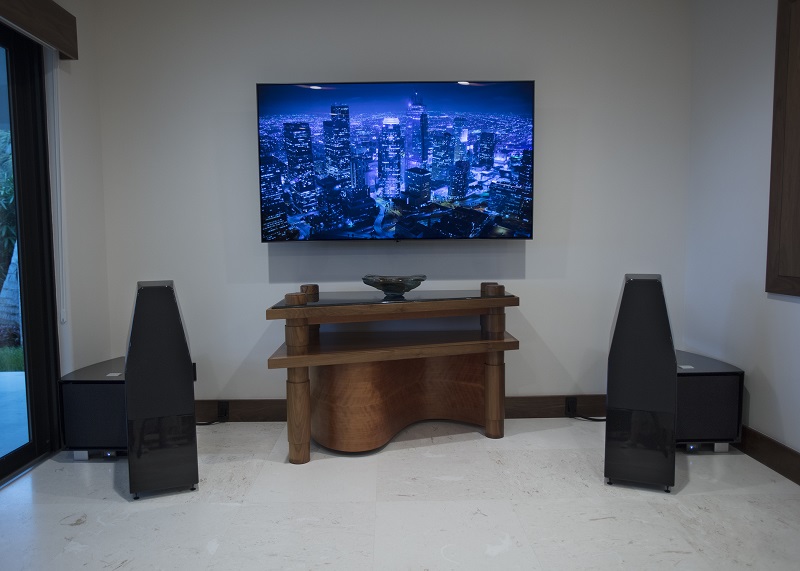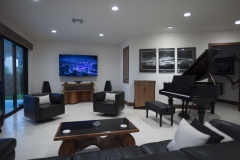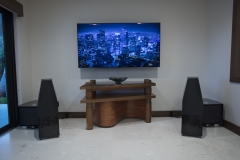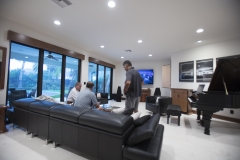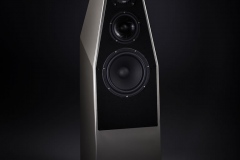If you’ve ever been around or spent time working or hanging around a passionate experienced and engineer Audiophile then perhaps this post will give you a few grins. Not because I am humorous or gifted in writing , no, in fact I’m just learning how to write about this stuff. But the grins, they’ll hit you because you are or do know an Audiophile who has this kind of Passion to make any sound system he touches to sound the best that it can possibly sound. And as the title suggests, tuning a system is not all black and white, not some simple check list to follow.
Ed asked me to go along with him to this customers system tuning. The goal was to tune a pair of high end REL Sub-base speakers to a stereo system already tuned for a pair of Wilson Audio Sabrina’s. I learned a lot from this day, so here we go.
The Question: How does one go about tuning a customers system, especially one that is not in an ideal, acoustically treated room? What methodology ought to be applied? (the featured image above shows the Wilson Audio Sabrina’s and the REL G1 Mark II Sub-base/sub-woofers, with the electronics in a concealed cabinet in the wall to the right)
Scenario: I went to my first customer system tuning session by Ed at a home that had a pretty high end system. And the setup was in a living room with a scenario that was not necessarily ideal for achieving optimal sound for the system. What do I mean?
Room Description: It was a beautiful living room, black & white decor, with some stunning natural wood pieces of furniture to accent the black and white tones. Ceramic tile floor, and an entire wall of glass (sliding doors) facing a pool/patio area. Flat Ceiling around 8 feet. Many reflective surfaces including Black & White photographic imagery of the other famous b&w photographer that would make one think of Ansel Adams, if he or she was not well schooled in the work of the two artists.
So, I’ll ask the question again, how does one go about tuning a fairly high end home Audio system in a somewhat hostile environment in regards to getting the best acoustic sound results, and walk away satisfied?
Note to whom might be new to the Audiophile world. Adding a pair or even a single sub-base/sub-woofer speaker to a 2 channel stereo system adds a fuller, more extended, and more dynamic bass range for a stereo system. The Wilson Sabrina’s do an excellent job with the 8 inch driver for bass down to 31 hz, however, by adding a sub-base speaker pair to the main speakers enables the listener to enjoy the bass extension deep into the 20 hz range, but more importantly, this allows the Sabrina to breath more within it’s design range, and let the recordings have their freedom should they have bass that is hungry for that 20-30hz region. (the G1’s do go down to 15 hz, though technically, the human ear I believe to around 19 hz)
I digressed a bit with the above, so back to our Audiophile Dr. approach if you will, to take this environment and bring the potential of the Speakers to their best possible sound in the room. Note: The Wilson Sabrinas were already tuned in by Ed on a previous occasion, but today’s tuning was to blend/tune the pair of newly added REL G1 Mark II Sub-base speakers into the system.
The Gear: The electronics are a McIntosh MA9000 Integrated 2 channel Amplifier (300 WPC). Speakers, as mentioned above, Wilson Audio Sabrina’s and REL G1 Mark II Sub-woofers. The source used was a streaming digital Bluesound unit that used the DAC built into the MA9000, even though the Bluesound unit actually does a surprisingly well job with it’s own built in little dac.
SEE PHOTO GALLERY BELOW.
So I was there for an observation experience only, and just watched and listened to Ed as he submerged his Audiophile listening ears to merge the REL’s with the Sabrina’s within this challenging “resonant rich” room. 🙂 Miguel assisted by changing settings and positioning, as they were shared by Ed.
With Ed Masterson, he approaches tuning a system from a more right brain aspect. He doesn’t let himself be dictated by numbers and settings, per say, but more, his approach is all about the listening. Listening for Tonality balance , phase timing, clarity & extension, airiness, etc. This requires getting up from the center “Sweet Spot” seat, making adjustments, and sitting back down. And, because Steve and his Wife do a lot of standing, Ed also kept checking the system from standing at the very back of the living room, close to the kitchen. (one of the photos show the depth & size of the living room) I’m just gonna go ahead and say this. For the most part, Ed is for the most part against “Room Correction or Eq Systems”. Bass tuning software, different story. Generally speaking, Ed is a tuning by listening first, not graphs and numbers etc. But, he does remain open minded to hear about new methods 🙂
It was amazing actually to watch Ed work. Word to the wise, Don’t interrupt him, unless he glances around asking for thoughts. He’s tunnel vision. You will break his flow when he is hyper focused in a tuning session. So, he started off, by listening for the timing or phase of the subs with the Sabrina’s, to make sure the subs were adding and not canceling out any of the low end sound. If the drivers are pushing out on the main speakers, well, you want the sub-woofer to be in phase with the speakers and be pushing out also. At the same time, it appeared he also addressed any bloating or excessive base that seemed to be apparent with the subs, simply because they had not been tuned yet to the room. This he addressed slowly over the next 1.5 or so hours thru constantly re-positioning the subs, fine tuning the volume, the crossover settings as he brought these two piano gloss black beauties into harmony with this awesome system that Steve and His Wife owned.
Once Ed finds the spot, where the REL’s really seemed to energize the room, having that very deep extension, and pressurized the room, then he seemed to go into fine tuning orientation angle of the subs, tweaking the volume, the crossovers. As he’s doing this, Ed always uses his chosen 10 or 20 tracks to determine certain things or nuances in those songs, and whether the speakers are delivering those sounds, (and not hiding or canceling out) and within the correct sound stage width and depth. We seemed to be getting close after an hour or so, but something was eating away at Ed’s thoughts, and it just didn’t seem like he was going to address it with the movement and settings adjustments that Miguel had been doing so far as per Ed’s requests.
Then an idea out of left field hit Ed. (as it appeared to me) Now normally, most of our high end speakers and amplifiers (speaking as a newer 2-3 year Audiophile) are set up in 4 Ohm on the amplifier out setting. As this was the case with the MA 9000 McIntosh in Steve’s system. But Ed asked Miguel if we can experiment with the Amp, and connect the speaker cables to 8 Ohm out. This took an extra 15 or 20 minutes to change over. A wall board panel had to be removed with the drill so that the entire gear rack could be spun around in order to make the changeover to 8 Ohm to the speakers on the back of the integrated amplifier, instead of 4 Ohm. Once this was done, any remnants of weightiness or heavy bass had disappeared. (As I strive to learn Audiophile jargon thanks to the help of Robert Harley and his awesome “The Complete Guide to High-End Audio – 5th Edition”), I can’t help but express that when that magic base popped, and had energized the room, the mid-range also seemed to expose more of it’s awesome timbre and clarity along with the treble. With another 10 or 15 minutes of fine tuning, Ed was happy. Then, Ed began listening to some of the tracks that Steve and His wife like to listen to, to make sure that these also sounded excellent.
On a final note, by switching the output over to 8 Ohm’s, it may have reduced a small amount of the base punch that would be more apparent at 4 Ohm’s, but Ed knew, that while he was tuning, it is always best to turn off the Equalizer (Frequency settings controls on a Mac which have 8 adjustment knobs from 25 Hz up to 10 kHz). It is made to have it on or off, depending on the listener. But for tuning, you definitely want it off. But now, if Steve wanted to increase the punch of the base or lower midrange, he could easily turn the Equalizer on the Mac right back on, make his frequency enhancements, and it would not accidentally alter or change the physical tuning that Ed and Miguel had done in the last couple hours.
In just an hour and a half to maybe two hours, Ed had turned this two channel stereo system with the new addition of 2 REL G1 Mark II subs into a very nice and powerful sounding system in what was a potentially hostile room for resonance issues with all the glass doors, piano, glass picture frames, ceramic floor, etc, for the Wilson floorstanders and/or the subwoofers. This, is Ed’s passion, and was a great learning experience for me.
Audible Images AV is excited to be serving: Melbourne, Florida, Rockledge, Merritt Island, Cocoa Beach, Cape Canaveral, Port St. John, Satellite Beach, Space Coast, Vero Beach, Orlando, Daytona, Kissimmee, Central Florida, the entire state of Florida…and even the greater USA, for all their Stereo two channel and Home Theater systems.

